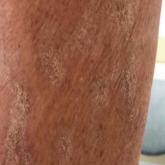Article

Atypical Localized Scleroderma Development During Nivolumab Therapy for Metastatic Lung Adenocarcinoma
- Author:
- Emma Fixsen, MD
- Jigar Patel, MD
- Meenal Kheterpal, MD
Immune checkpoint inhibitors such as nivolumab, a programmed cell death protein 1 (PD-1) inhibitor, are associated with immune-related adverse...
